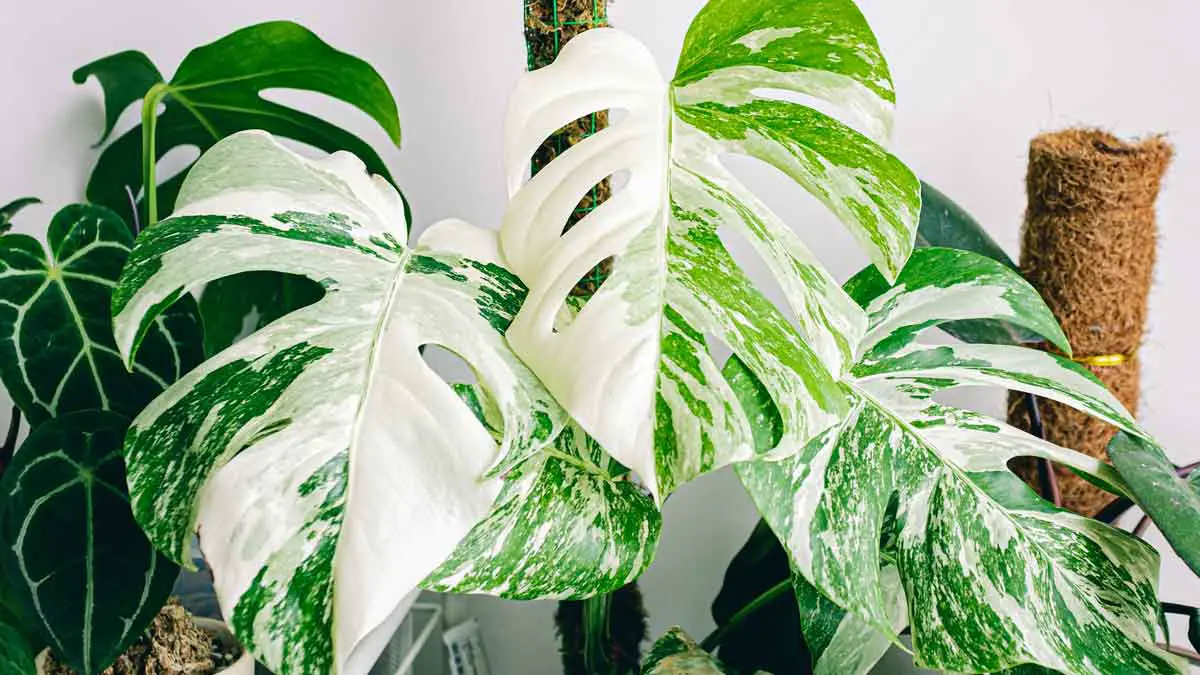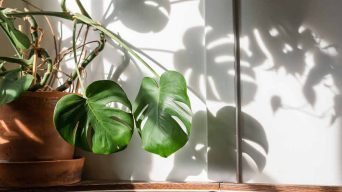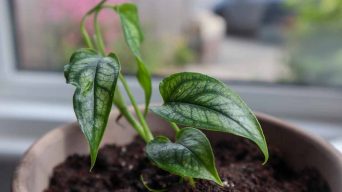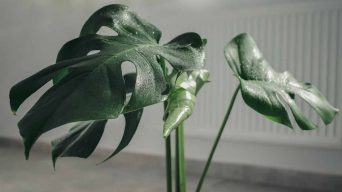Monstera plants prefer bright to medium-bright indirect light, can tolerate direct morning sun but avoid harsh afternoon sun, and can survive in low light conditions but grow slower. They need 5-12 hours of light per day and should be placed near a bright window but not directly exposed to sunlight to prevent burnt leaves.
Monstera plants, also known as the Swiss Cheese plant, are a popular choice for both experienced plant parents and those just starting out in the hobby.
With their unique foliage and relatively easy care requirements, it’s no wonder why these plants remain so popular!
However, one important factor in Monstera care that often gets overlooked is lighting.
To ensure your Monstera plant thrives, it’s important to understand how much light your plant needs.
In this guide, we’ll discuss everything you need to know about Monstera lighting requirements.
We’ll cover topics like identifying the signs of too much or too little light and what you can do to ensure your Monstera plant is getting just the right amount of light.
So, if you want to provide the best care for your indoor Monstera plant, keep reading to learn more about how much light it needs!
Monstera Light Requirements
To understand Monstera light requirements, it’s important to consider their origins.
Monstera plants are native to the rainforests of Central and South America, where they grow under the shade of taller trees. This means they are adapted to bright to medium-bright indirect light rather than direct sunlight.
In their natural habitat, Monstera plants receive filtered sunlight through the dense foliage of the rainforest canopy.
The Monstera plant’s roots are adapted to absorb moisture and nutrients from the humid soil of the rainforest, allowing it to thrive in its natural environment with indirect, filtered sunlight from the rainforest canopy above.
This allows them to absorb the necessary light for photosynthesis without being subjected to the harsh, direct rays of the sun.
Therefore, it’s important to mimic these growing conditions as much as possible when caring for Monstera plants at home.
Monstera plants can tolerate some direct morning sun, but it’s important to avoid exposing them to the harsh afternoon sun. The afternoon sun is much stronger than the morning sun and can easily scorch Monstera leaves.
If you’re unable to provide bright indirect light, you can still grow a Monstera plant in lower light conditions.
However, be aware that this will result in slower growth. The Monstera plant may become leggy as it reaches the light.
It’s important to note that there is a balance to be struck between providing enough light and not overexposing your plant.
If you’re unsure how much light your Monstera plant needs, start by placing it in a bright room with indirect light and gradually increasing its exposure to direct sunlight.
You can also observe the plant’s behavior – if the leaves are turning brown or yellow, it’s likely getting too much direct sun.
Monstera plants prefer bright to medium-bright indirect light, but they can survive in lower light conditions.
As with all houseplants, monitoring their behavior and adjusting their growing conditions is important.
Providing the right amount of light can help your plant thrive and add a touch of tropical beauty to your home.
How Many Hours of Light Does a Monstera Need?
If you’re a proud Monstera plant owner, you may wonder how many hours of light your plant needs to thrive.
The answer isn’t straightforward, as several factors influence the amount of sunlight a Monstera plant needs.
Generally, Monsteras require 5-12 hours of light per day to grow and thrive. However, this range can vary depending on the specific variety of Monstera and its environment.
Some Monstera varieties, such as the Monstera deliciosa, require more light than others. If you’re unsure about your Monstera’s light requirements, research the specific variety to determine how much sunlight it needs.
In addition to plant variety, the environment in which your plant is growing can impact its light needs.
If your Monstera plant is located in a room with bright indirect sunlight, it may require fewer total hours of light per day.
Conversely, if your Monstera plant is located in a room with low light, it may require more hours of direct or indirect sunlight.
It’s important to monitor the amount of light your Monstera plant is receiving to ensure it’s getting enough but not too much.
If your Monstera plant is getting too little light, you may notice it becoming leggy as it stretches toward the light source. The leaves may also become smaller and darker in color.
On the other hand, if your Monstera plant is getting too much light, you may notice the leaves turning yellow or brown, which can indicate sunburn.
Observe your Monstera plant’s behavior and appearance to monitor its light needs.
If you notice it reaching toward the light source, it may need more light. If you notice the leaves turning yellow or brown, it may need less direct sunlight.
You can also use a light meter or app to measure the amount of light your Monstera plant is receiving.
In addition to monitoring the amount of light your Monstera plant is receiving, it’s also important to consider the quality of the light.
Monstera plants prefer bright indirect light rather than direct sunlight, which can scorch their leaves.
If your Monstera plant is located near a window with direct sunlight, consider using a sheer curtain to filter the light.
Signs That a Monstera Needs More Light
It’s important to keep an eye on your plant’s health and well-being. One key aspect to monitor is the amount of light your Monstera is receiving.
While these tropical plants are hardy and adaptable, they do have specific light requirements that, if not met, can lead to signs of distress.
If your Monstera plant is not receiving enough light, you may notice some of the following signs:
1. Yellowing of Leaves
One of the most obvious signs that your Monstera plant needs more light is the yellowing of leaves.
This can happen for a few reasons, but if your plant is getting too little light, it can cause Monstera leaves to turn yellow or brown.
When a plant doesn’t receive enough light, it can’t photosynthesize properly, leading to the breakdown of chlorophyll in the leaves.
Without enough chlorophyll, the leaves can’t stay green, resulting in yellowing or browning.
2. Stunted Growth
If you notice that your Monstera plant is not growing as quickly as it should, it could be a sign that it needs more light.
Plants require a certain amount of light to photosynthesize and produce energy for growth.
Without enough light, the plant may not have the energy it needs to grow to its full potential, resulting in stunted growth.
3. Leggy Growth
Another sign that your Monstera plant needs more light is leggy growth.
This occurs when the plant stretches out towards the light source, resulting in a tall, spindly appearance.
While some leggy growth is normal, excessive legginess can be a sign that your plant is not getting enough light.
This can also be accompanied by smaller leaves and less foliage, as the plant is directing its energy towards reaching for the light instead of producing leaves.
4. Small Leaves
If your Monstera plant is not getting enough light, you may notice that its leaves are smaller than usual.
This is because the plant is not able to photosynthesize as much as it should, leading to slower growth and smaller leaves.
While some Monstera varieties naturally have smaller leaves, if you notice a sudden decrease in leaf size, it could be a sign that your plant needs more light.
5. Slow Growth
Finally, if your Monstera plant is growing slower than usual, it could be a sign that it needs more light.
Plants require a certain amount of light to produce energy for growth and reproduction.
Without enough light, the plant may not be able to grow as quickly as it should, resulting in slow growth.
Signs That a Monstera Is Getting Too Much Light
In addition to watching for signs of too little light, it’s important to be aware that your Monstera is getting too much light.
While Monstera plants prefer bright, indirect light, too much direct sunlight can cause them stress and even lead to scorching of the leaves and stems.
If you notice any of the following signs, it could be a sign that your Monstera is getting too much light:
1. Brown, Scorched Leaves
One of the most obvious signs that a Monstera is getting too much light is the appearance of brown, scorched leaves.
When a plant is exposed to too much direct sunlight, the leaves can become burned and damaged.
The tips and edges of the leaves may turn brown and crispy, and the overall appearance of the plant may begin to look unhealthy.
2. Crispy, Dry Leaves
In addition to brown, scorched leaves, a Monstera that is getting too much light may also have leaves that are dry and crispy to the touch.
This can occur because the excess light causes the plant to lose moisture more quickly than it can absorb it. As a result, the leaves may become brittle and fragile.
3. Foliage Becoming Pale
Another sign that a Monstera is getting too much light is when the foliage begins to become pale.
This occurs because the excess light causes the plant to produce less chlorophyll, which is the pigment that gives leaves their green color.
As a result, the leaves may appear lighter or even yellowish in color.
4. Wilting or Drooping Leaves
If a Monstera is getting too much light, the leaves may also begin to wilt or droop.
This can happen because the excess light causes the plant to lose water more quickly than it can absorb it.
As a result, the leaves may appear limp or wilted, and the overall appearance of the plant may look sad and lifeless.
5. Reduced Growth
When a Monstera is exposed to too much light, it may also experience reduced growth.
This can happen because the excess light causes the plant to use up its energy more quickly than it can produce it through photosynthesis.
As a result, the plant may grow more slowly or even stop growing altogether.
6. Leaf Loss
When a Monstera is getting too much light, it may also begin to lose its leaves.
This can occur because the excess light causes the plant to become stressed and weakened.
As a result, the leaves may fall off the plant prematurely, leaving it looking bare and sparse.
Tips for Providing Adequate Light for a Monstera
Now that you know the signs of too much and too little light, it’s time to ensure your Monstera is getting just the right amount.
Here are some tips for providing adequate light for a Monstera:
Placement Near a Bright, Filtered Window
In order to provide adequate light for a Monstera, it is important to place it in an area near a bright, filtered window that receives plenty of indirect sunlight throughout the day so that the plant can thrive and grow.
Monstera plants prefer bright to medium, bright indirect light, which is often found near windows with sheer curtains or blinds.
South-facing windows may provide too much direct sunlight, which can cause damage to the leaves. On the other hand, north-facing windows may not provide enough light for optimal growth.
An east or west-facing window is typically ideal for Monstera plants. These orientations offer a good balance of indirect sunlight, preventing the plant from getting too much direct sun exposure that could harm its leaves.
Placing the Monstera near an east or west-facing window ensures it receives the appropriate amount of natural light throughout the day, promoting healthy growth and vibrant foliage.
If your plant is near a window, be sure to rotate it regularly to ensure all parts of the plant receive adequate light.
Use of Artificial Lighting in Low Light Conditions
In low-light conditions, you may need to supplement natural light with artificial lighting.
Fluorescent lighting is an ideal choice for Monstera plants, as it provides the full-spectrum of light they need for optimal growth, including the blue and red wavelengths that are essential for photosynthesis and the yellow and green wavelengths that help the plant to thrive.
Grow lights are essential components of any indoor gardening setup, as they provide the necessary light for your plants to thrive and grow. T
hey can be easily mounted above your Monstera to ensure that your plants receive the optimal amount of light for their growth.
Avoidance of Direct, Harsh Sunlight
Monstera plants thrive in bright, moderately intense light but should be kept away from direct, harsh sunlight, as its intensity can cause damage.
The intense heat from direct sunlight can lead to burned leaves on the Monstera plant, resulting in brown or scorched spots.
If your Monstera is positioned near a window, make sure it’s shielded from the direct rays of the sun by either a sheer curtain or a blind.
Too much direct sunlight can damage the leaves of the plant and cause it to become stressed, leading to a decrease in growth and overall health.
To ensure the best growing conditions for your Monstera, it’s best to place it in a spot in the house that receives indirect light, such as near a window that’s not exposed directly to the sun.
Providing Adequate Shade
When selecting a location for your Monstera plant, it is important to ensure that it is not in direct sunlight and that there is adequate shade available, as these plants require indirect light to thrive.
When plants receive too much direct light, it can lead to a variety of problems, such as pale and wilted leaves, stunted growth, and even death.
Providing shade through curtains, blinds, or sheer fabric can help filter the light and protect your plant from harsh rays.
Proper Watering
Proper watering is also essential for the health of your Monstera.
Overwatering or underwatering can lead to stunted growth or yellowing leaves, regardless of the amount of light the plant receives.
Be sure to water your Monstera when the top inch of soil feels dry to the touch.
Ensure the pot has proper drainage to prevent waterlogged soil, as excessive moisture can result in root rot.
Regular Monitoring of Light Levels and Adjusting Placement as Needed
Lastly, it’s essential to monitor the amount of light your plant receives regularly.
While Monstera plants can tolerate low light conditions, they will grow much slower and may become leggy if they do not receive enough light.
On the flip side, an excess of light can lead to Monstera leaf loss or the development of brown spots on the leaves.
As the seasons change, it is important to pay attention to the amount of light your plants receive and adjust their placement accordingly, as the amount of light they need can vary depending on the season.
Regularly monitoring the light levels and adjusting your plant’s placement as needed can help ensure it receives the proper amount of light.
Final Thoughts
Monstera plants bring a lush, tropical beauty to any home in a way that is visually appealing and easy to maintain, as long as it receives the proper amount of light, making it a great choice for anyone looking to add a touch of greenery to their living space.
To ensure your Monstera is flourishing and healthy, you must provide the right amount of light.
Too much direct sunlight can cause the leaves to turn brown and scorch, while insufficient light will cause them to become pale, and growth will be stunted.
Monitor your Monstera’s light levels closely and adjust its placement accordingly to guarantee that it is getting an adequate amount of light.
With proper care and attention, your Monstera houseplant will thrive and fill your home or garden with its vibrant foliage.







